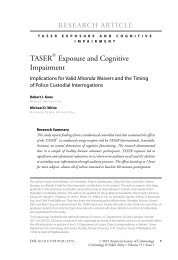1qaSADJ
1qaSADJ
1qaSADJ
Create successful ePaper yourself
Turn your PDF publications into a flip-book with our unique Google optimized e-Paper software.
Special Focus:<br />
Writing Persuasively<br />
all the mares he bred to were Morgans as well. The Morgan horse, America’s<br />
first original breed of horse, is bred to be a great athelete, and bloodlines<br />
are carefully analyed to insure the best possible offspring.<br />
“Nate” sired several foals, all of which went on to be successful show<br />
horses themselves and, in some cases, have offspring of their own. It was<br />
then discovered that Nate wasn’t a Morgan. In fact, he was half Saddlebred,<br />
an entirely different breed. As it turned out, the man who bred Nate in<br />
the first place knew. He purposely bred a Morgan stallion to a Saddlebred<br />
mare and, by changing the mare’s name and claiming she was a Morgan,<br />
registered Nate as a full-blooded Morgan.<br />
The Morgan Horse Association panicked. Suddenly over 40 horses in<br />
the registry were found to be related to Nate, and therefore could not be<br />
considered Morgans. Intent on keeping the breed pure, the Association<br />
decided to remove the horses from the registry altogether, therefore<br />
forbidding them to compete or breed. Furious owners retaliated, and<br />
dozens of court hearings and lawsuits took place, eventually leaving the<br />
Association with under $1,000 in its bank account.<br />
Finally, the American Morgan Horse Association won out over the course<br />
of two years of controversy. Still, the owners of the expelled horses need<br />
somewhere to compete. These horses had cost them thousands of dollars,<br />
and they refused to lose that amount of money in horses they couldn’t<br />
use. The Association discussed the situation and decided to create a<br />
special “open breed” competition at Morgan show. Now not only can these<br />
talented horses compete, but the Morgan Horse can remain pure.<br />
Recently a class of 17 AP seniors (all of whom had taken the AP English Language Exam<br />
in spring 2004) considered this sample as a revision exercise. Their immediate responses<br />
after reading the prompt and the essay were—unsurprisingly—confident. They were<br />
quick to see the problems of the essay, and enjoying the comfort of retrospection, each<br />
was sure that his or her essay written on the question last May had not been beset with<br />
such obvious problems. Assigned to groups of three and four, the students were first<br />
asked to look at the essay’s successes. They were surprised; they had assumed that the<br />
focus of the activity would be on the essay’s problems and weaknesses. AP students are<br />
generally comfortable pointing out errors and problems—a mirrored response of their<br />
teachers, I think. Nonetheless, they began to work with the successes of the essay as a<br />
way of understanding and revising the problems, and I was struck by how much more<br />
AP® English Language and Composition: 2006–2007 Workshop Materials 19



